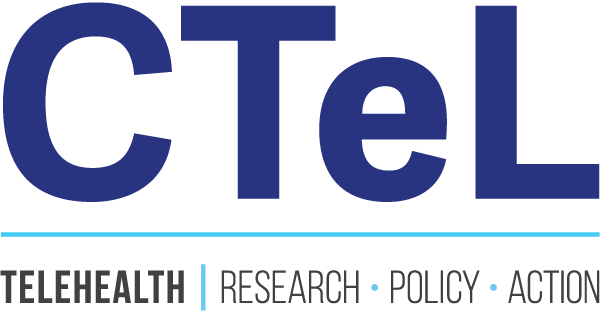
What is Telehealth?
The Health Resources and Services Administration (HRSA) of the U.S. Department of Health and Human Services (HHS) defines telehealth as the use of electronic information and telecommunications technologies to support and promote long-distance clinical health care, patient and professional health-related education, and public health and health administration. Technologies include videoconferencing, the internet, store- and-forward imaging, streaming media, and landline and wireless communications.
-
Virtual care is an umbrella term referring to the use of technology to provide remote healthcare services, including but not limited to: telehealth/telemedicine, remote monitoring, artificial intelligence.
-
Sometimes called telemedicine — refers to the use of digital communication technologies, such as video calls and online platforms, to provide medical services and consultations remotely, allowing patients and healthcare professionals to interact without being in the same physical location. In other words, healthcare from anywhere, without the need for an in-person office visit.
Telehealth allows practitioners the ability to see a patient by telehealth if the provider establishes an appropriate practitioner-patient relationship as defined by the state [link to states page when established] licensure board where the patient is located. The INTIAL examination needs to meet the medical standard of care and comply with the states examine requirements. If the practitioners are prescribing controlled substances by telehealth, they must also comply with the DEA (Drug Enforcement Administration) and the Ryan Haight Act. The practitioner has flexibility with follow-up and subsequent encounters with the patient if that patient is being seen for the same medical condition.
-
-Talk to your health care provider live over the phone or video chat.
-Send and receive messages from your health care provider using secure messaging, email, and secure file exchange.
-Use remote monitoring so your health care provider can check on you at home. For example, you might use a device to gather vital signs to help your health care provider stay informed on your progress.
How does telehealth work?
The Telehealth Process Simplified
Telehealth enables patients and providers to connect efficiently, ensuring timely and effective care. Here is a general outline of how the process works:
Step 1: Appointment Scheduling
Patients can book an appointment online or via phone. The scheduling system allows selecting a preferred date and time while gathering initial details about the patient’s health concerns.
Step 2: Information Collection
Before the consultation, patients provide necessary details, including symptoms, medical history, and current medications. If any information is missing, the system prompts the patient to complete the profile for a seamless consultation.
Step 3: Telehealth Consultation
At the scheduled time, the patient meets with a licensed provider through a secure video or audio platform. During the session:
The provider discusses the patient’s concerns and medical history.
A diagnosis is provided, and a treatment plan is outlined.
If additional tests or an in-person visit are required, the provider gives clear instructions for next steps.
Step 4: Post-Consultation Follow-Up
Following the consultation, the patient receives support to ensure proper care. This may include:
Prescriptions sent to a pharmacy.
Therapy plans or lifestyle recommendations.
Referrals for further testing or specialized care if needed.
End of Process: Care Summary
To ensure continuity of care, patients are provided with a detailed summary of their consultation, including the diagnosis, treatment plan, and any necessary follow-up steps.
Telehealth simplifies access to healthcare, offering convenience, clarity, and comprehensive support at every stage.
What conditions can be treated with Telehealth?
-
Common cold, flu, sinus infections, sore throat, and allergies can often be diagnosed and treated through telehealth consultations. Respiratory conditions such as bronchitis and pneumonia can be assessed remotely, with prescriptions and treatment plans provided, as necessary. Non-severe injuries like sprains, minor fractures, and strains can be evaluated through telehealth, with recommendations for further care if needed.
-
Patients with chronic conditions like diabetes, hypertension, asthma, and heart disease can receive ongoing monitoring, medication management, and lifestyle counseling through telehealth.
-
Telehealth is highly effective for providing therapy, counseling, and support for conditions like anxiety, depression, stress, and other mental health concerns.
-
Skin conditions such as rashes, acne, eczema, and psoriasis can be diagnosed and treated through telehealth by sharing images and descriptions with healthcare providers.
-
Telehealth can be used to renew prescription medications, receive guidance on management and interactions, and adjust dosages for various health conditions.
-
After initial in-person appointments, follow-up consultations can be conducted via telehealth to monitor progress and adjust treatment plans.
-
Telehealth can be used for consultations with nutritionists and dietitians to address weight management, dietary concerns, and nutritional advice.
-
After surgical procedures, patients can have virtual follow-up appointments to discuss recovery progress and address any concerns.
-
Patients recovering from injuries or surgeries can receive guidance on exercises and rehabilitation techniques through telehealth.
-
Telehealth provides a confidential platform for individuals seeking help with quitting smoking or managing addiction.
What are the benefits of Telehealth?
-
Telehealth allows patients to receive medical care from the comfort of their own homes, eliminating the need for travel and reducing waiting times.
-
It improves access to healthcare for individuals in remote or underserved areas, enabling them to connect with healthcare professionals who might not otherwise be available.
-
Telehealth appointments often have shorter wait times and more flexible scheduling, saving both patients and healthcare provider time.
-
Patients can avoid travel expenses and time away from work, while healthcare systems can reduce administrative costs associated with in-person visits.
-
Telehealth facilitates regular check-ins and follow-ups, ensuring consistent monitoring and management of chronic conditions.
-
Especially relevant during outbreaks like COVID-19, telehealth reduces the risk of exposure to contagious illnesses by minimizing in-person contact.
-
Patients can easily consult with specialists who may be located far away, reducing the need for long-distance travel.
-
Telehealth provides seniors with easier access to medical consultations and monitoring, enabling aging in place and maintaining independence. description.
-
Telehealth enhances access to mental health services, making it more convenient for individuals to seek counseling and therapy.
-
Telehealth helps bridge gaps in healthcare access, making medical services more equitable for disadvantaged populations.
*The benefits of telehealth can vary based on individual circumstances and healthcare systems, but these points provide a general overview of its advantages.
Telehealth Policy 411: What You Need to Know
To secure legislation making telehealth access permanent, congress needs the right research and information for an accurate Congressional Budget Office (CBO) score. To accurately score the Telehealth Modernization Act (TMA) for its permanent implementation, Congress and the CBO should undertake the following steps:
Comprehensive Data Collection: Gather extensive data on telehealth utilization, costs, and outcomes. This includes analyzing spending patterns, service usage, and patient outcomes within Medicare, as well as reviewing studies on telehealth's impact on healthcare delivery and costs.
Evaluate Substitution vs. Supplementation Effects: Assess whether telehealth services replace in-person visits (substitution) or add to overall healthcare utilization (supplementation). Understanding this distinction is crucial, as increased utilization can lead to higher costs.
Analyze Payment Parity Implications: Examine the effects of reimbursing telehealth services at rates equivalent to in-person visits. Consideration should be given to whether this parity leads to increased utilization and spending, or if adjusted rates could better align with the cost structure of telehealth services.
Monitor for Fraud and Abuse: Implement measures to detect and prevent fraudulent activities within telehealth services. This includes establishing monitoring systems to identify outlier billing patterns and ensure compliance with healthcare regulations.
Consider Long-Term Projections: Incorporate long-term cost projections, potentially extending beyond the standard 10-year budget window, to fully capture the financial implications of making telehealth provisions permanent. This approach can provide a more accurate assessment of future costs and savings.
Legislative Coordination: Ensure that legislative proposals include detailed provisions addressing the above factors. Clear legislative language can facilitate a more precise CBO scoring process by outlining the scope, limitations, and intended outcomes of the telehealth services to be covered.
By following these steps, Congress can work with the CBO to develop an accurate and comprehensive budgetary score for the Telehealth Modernization Act, facilitating informed decision-making regarding its permanent implementation.



